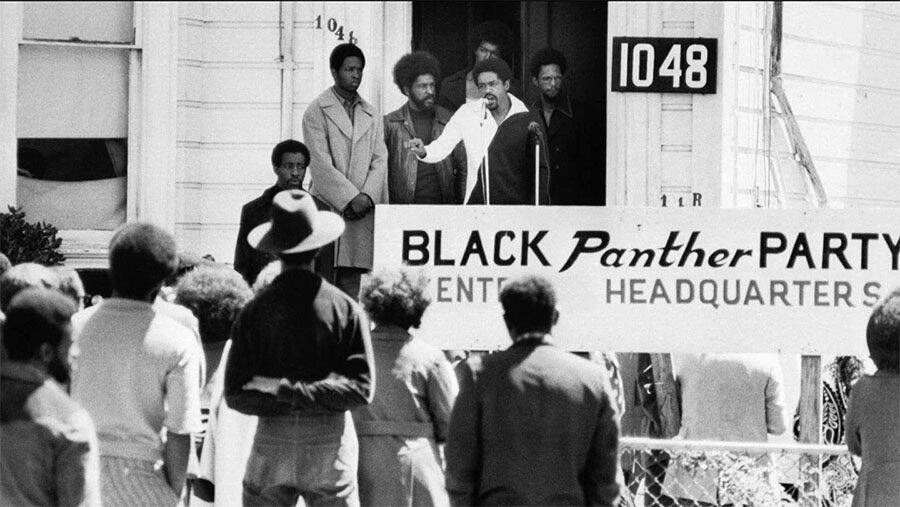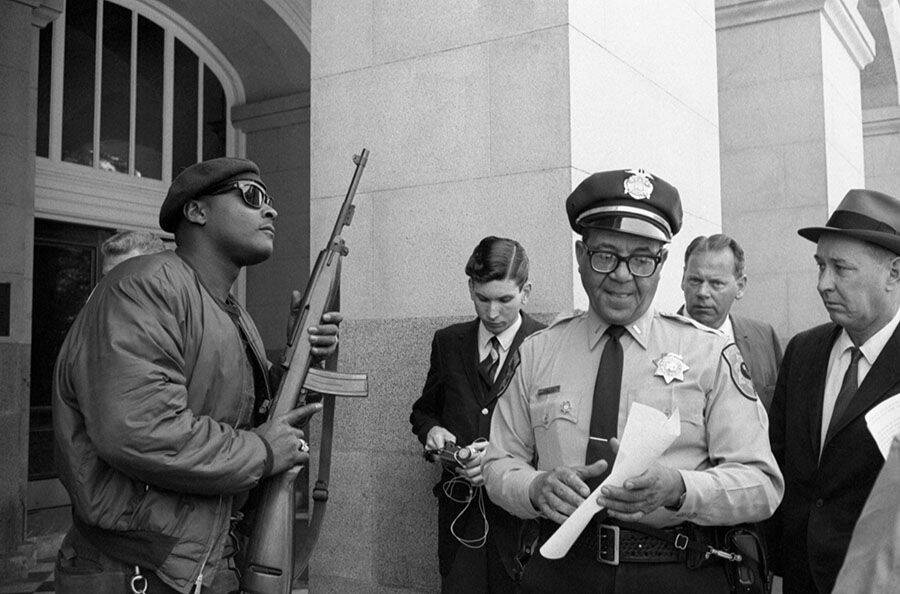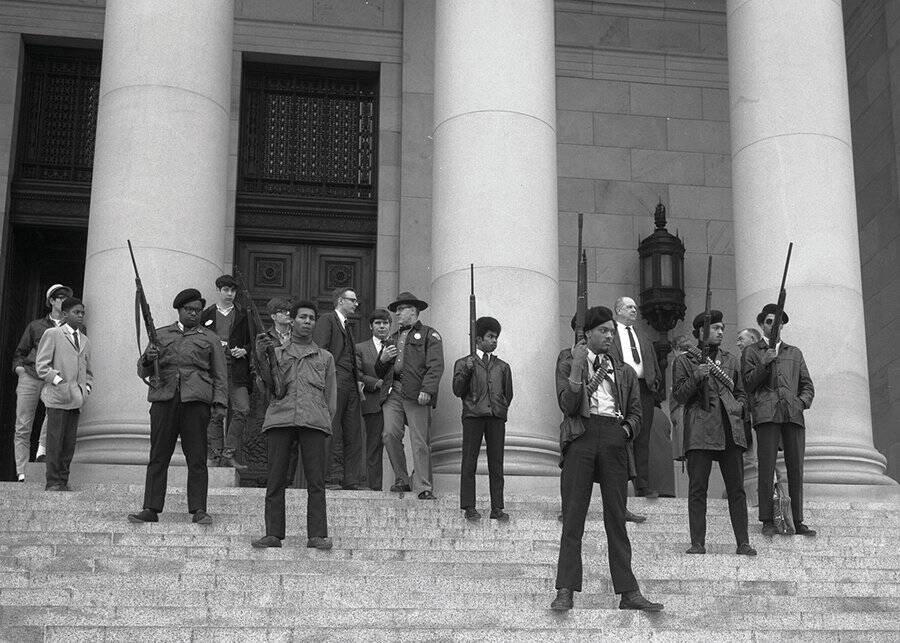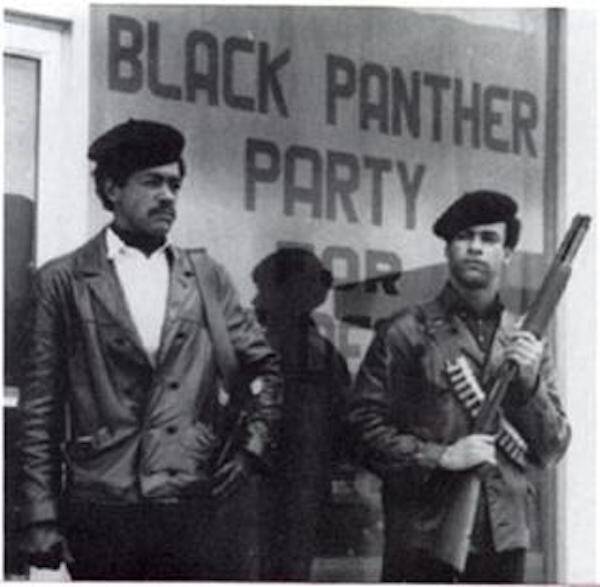When the Black Panthers took up arms to protect their communities, governments passed new laws stripping their gun rights — and used military tactics to enforce them.

Vimeo/The New York TimesIn response to police brutality against black Americans in the 1960s, Bobby Seale and Huey P. Newton founded the Black Panther Party for Self-Defense in Oakland, California, to challenge and confront police abuse against African-Americans.
The 1960s were one of the most tumultuous decades in living memory and nowhere was that more evident than in the American Civil Rights Movement. Responding to centuries of systemic oppression, African-Americans mounted a multi-faceted resistance that ranged from Rev. Martin Luther King Jr.’s non-violent civil disobedience to the “Any Means Necessary” black liberation militancy of Malcolm X.
So when the Black Panthers’ started openly displaying firearms and promised to defend their communities against police violence, it created a panic among many segments of white America who pushed governments to respond by enacting strict gun control measures — which even the National Rifle Association supported.
When the Panthers still refused to disarm, authorities escalated the conflict with arrests, use of fabricated evidence, and a campaign of harassment that quickly descended into the gangland-style assassination of members of the Panthers’ leadership. Amazingly, this was just the prelude to an infamous Dec. 8, 1969, raid on the Black Panthers’ headquarters in Los Angeles by the L.A.P.D.
Expecting resistance, police deployed hundreds of officers during the operation and introduced its newly-created S.W.A.T. team — the first-ever use of such a police unit in U.S. history — to storm the building. A violent stand-off ensued that lasted for more than four hours, but the raid’s legacy as America’s first step toward militarized police is more relevant today than ever.
The Rise Of The Black Panthers
Huey Newton and Bobby Seale founded the Black Panther Party in Oakland, California, in 1966, in response to rising police brutality against members of the African-American community.
Their initial focus was patrolling African American neighborhoods in Oakland to monitor the activities of police officers. Formally called the Black Panther Party for Self-Defense, they quickly drew widespread support from other cities with large minority communities like Chicago, Los Angeles, New York, and Philadelphia.
At their height, the Black Panthers had chapters located in 48 states in the U.S. Additionally, they had support groups located in several countries including England, France, Germany, Sweden, China, Japan, Uruguay, Mozambique, and South Africa.
Spurning the “peaceful resistance” tactics of Martin Luther King, Jr., the Black Panther Party was inspired by Malcolm X, who had been assassinated a year earlier, on February 21, 1965.

Library of CongressMalcom X, March 1964.
Malcolm X argued that the United States government was “either unable or unwilling to protect the lives and property” of African Americans. Therefore, he thought they had to defend themselves “by whatever means necessary,” including the public display of firearms.
Malcolm X pointed to the Constitution to support this premise. “Article number two of the constitutional amendments,” Malcolm X stated, “provides you and me the right to own a rifle or a shotgun.”
Black Panther co-founder Huey Newton discovered that it was legal to carry a firearm in public in California while attending classes at the University of San Francisco’s School of Law. That law had two stipulations: the gun must be publicly displayed and could not be pointed menacingly at anyone.
Newton wrote in his autobiography, Revolutionary Suicide: “Before I took Criminal Evidence in school, I had no idea what my rights were.”
Firearms quickly became central to the Black Panther Party’s identity, and they taught their recruits that “the gun is the only thing that will free us, gain us our liberation.” Black Panther members began carrying firearms in public and they took particular pleasure in displaying them to police officers.
Black Panther Traffic Stop With Oakland PD

Wikimedia CommonsAs Black Panther co-founder Bobby Seale explained, “Malcolm X had advocated armed self-defense against the racist power structure.” Thus, the Black Panther Party armed itself as a way to “police the police” and ensure that police interactions with African-Americans did not culminate in violence.
Things came to a head in February 1967 when Oakland police officers stopped a car carrying Huey Newton, Bobby Seale, and several other Black Panther members.
In one instance, a car carrying members of the Black Panthers was filled with rifles and handguns, and when one of the policemen asked to see one of the firearms, Newton refused.
“I don’t have to give you anything but my identification, name, and address,” he told the officer.
“Who in the hell do you think you are?” the policeman responded.
Newton mocked the officer, responding, “Who in the hell do you think you are?”

Wikimedia CommonsThe practices of Malcolm X help lay the philosophical groundwork for the Black Panther Party. Indeed, Malcolm X held an “any means necessary” approach to the fight for equality, a tenet he famously underscored in his “it’s either the ballot or the bullet” 1964 speech on African-American voting rights.
At that point, Newton exited the car carrying a rifle and approached the police officers.
“What are you going to do with that gun?” a stunned policeman asked.
Newton responded, “What are you going to do with your gun?”
A crowd of onlookers began to form as Newton continued to confront police officers. The officers ordered the crowd to disperse, but Newton hollered at them to stay and witness the incident.
After advising the crowd that under California law civilians were allowed to observe officers making an arrest, Newton turned his attention back to the policemen.

Jack Manning/New York Times Co./Getty ImagesBlack Panther Party members outside the Criminal Courts Building in New York, May 1, 1969. They are protesting following the charging of 21 Panthers with a plot to blow up New York City stores, railway infrastructure, and a police station.
Playing it up for the crowd, Newton proclaimed: “If you try to shoot at me or if you try to take this gun, I’m going to shoot back at you, swine.”
Concerned about the growing crowd and Newton’s confrontational demeanor, the police officers eventually stood down, and Newton and the other occupants of the car were allowed to leave the scene without being arrested.
Newton later wrote of the police: “It was sometimes hilarious to see their reaction.”
“They had always been cocky and sure of themselves as long as they had weapons to intimidate an unarmed community,” he continued. “When we equalized the situation, their real cowardice was exposed.”
There were several such standoffs between Black Panthers and the police to come — with tensions only ratcheting up higher as time went on.
The Black Panthers March On California’s State Capitol

Wikimedia CommonsBobby Seale and Huey Newton on patrol with a Colt .45 and a shotgun.
Emboldened by the success of these standoffs with police, Black Panther Party members became more assertive instead of reactive, openly carrying their firearms on the streets and following police around town as they conducted their patrols.
They called these activities “police patrols,” and they also began dispensing legal advice to African Americans stopped or otherwise detained by police officers.
Adam Winkler, the author of Gunfight: The Battle Over the Right to Bear Arms in America, wrote about those patrols:
“Bobby Seale and Huey Newton used the Second Amendment to justify carrying guns in public to police the police. The Panthers would stand to the sidelines with their guns, shouting out directions to the person. … That they were watching and that if anything bad happened that the Black Panthers would be there to protect them.”

Bettmann/Contributor/Getty ImagesTwo members of the Black Panther Party are met on the steps of the California State Capitol in Sacramento by Police Lt. Ernest Holloway, who informs them they will be allowed to keep their weapons as long as they cause no trouble and do not disturb the peace. May 2, 1967.
It was May 2, 1967 when two dozen Black Panthers entered the California state Capitol and 10 positioned themselves at the back of the Assembly Chamber. The Assembly was in session at the time, with Speaker Carlos Bee ordering their removal.
The 30-something men were initially disarmed, though police had to return them their weapons once it was clear they hadn’t broken any laws. Nonetheless, they were all forcibly taken to the city jail.
“We’re going to take them all down and check them all out and we’re going to check out all these weapons,” an officer at the scene said.
Bobby Seale, meanwhile, stood outside the police department in question and read the following statement:
“The Black Panther Party for self-defense calls upon the American people in general and the black people in particular to take careful note of the racist California Legislature which is considering legislation aimed at keeping the black people disarmed and powerless at the very same time that racist police agencies throughout the country are intensifying the terror, brutality, murder and repression of black people.”
To his point, members of the National Rifle Association and California State Assembly were increasingly concerned about the apparent growing militancy of the Black Panther Party.
They had been pushing for passage of the Mulford Act — which would overturn the law allowing California residents to openly carry firearms.
The bill was introduced to the State Assembly in April 1967, was passed on July 26 and was signed into law by then-Governor Ronald Reagan two days later on July 28, 1967.
The Murder Of Fred Hampton And The 1969 Standoff
Fred Hampton’s status as a civil rights hero and American icon was tragically cemented when he was murdered in early morning hours of Dec. 4, 1969, during a Chicago police raid on a West Side apartment.
Hampton was barely 21 years old but had already become the Illinois chief of the Black Panther Party. The conflict between the Black Panthers and the police had increased in the months preceding his death: A July shootout saw five cops and three panthers wounded, while two cops were killed and six wounded in a November gunfight.

Wikimedia CommonsThe bed of Fred Hampton, after he was shot in the head, twice, at point-blank range.
It was FBI informant William O’Neal who infiltrated the Panthers and provided his intelligence handler with a sketch of Hampton’s apartment. “He wanted to know if we had explosives,” O’Neal said of his handler. “Who spent the night where.”
At 5 a.m. on Dec. 4, police burst into Hampton’s home and initiated a “wild gun battle” that lasted 20 minutes. Most of the Panthers were asleep. Hampton and Mark Clark, a Panther on guard duty, were killed. Two men, a woman, and a 17-year-old girl were wounded. One cop was too.
Figures like Rev. Ralph Abernathy — heir to Martin Luther King Jr.’s crusade for peace — spoke at Hampton’s funeral. “The nation that conquered Nazi Germany is following the same course as brutal Nazi Germany,” he said.
A grand jury would later investigate the raid and found that of the 76 expended bullets found in the apartment, only one was traceable to a Black Panther.
This raid would be a tragic preview of what was to come just four days later on Dec. 8, 1969, in Los Angeles. Chronicled in a new Netflix documentary, The Stand Off, the L.A.P.D. — acting off false information provided by the F.B.I. — went to serve a search warrant on the Los Angeles headquarters of the Black Panther Party, looking for a cache of stolen weapons.
The LAPD had just formed the Special Weapons And Tactics (SWAT) team — which would be used for hostage scenarios to come but also ruthlessly employed in inner-city situations during the tumultuous crime wave to come. The operation to carry out the search involved more than 200 police officers who were armed with thousands of rounds of ammunition, gas masks, a helicopter, and a tank.
The chief of the L.A.P.D. had even received permission from the U.S. Department of Defense to use a grenade launcher on the Black Panthers if they resisted.
Bernard Arafat, a 17-year-old runaway-turned-Black Panther, was sleeping in the 41st St and Central Avenue headquarters when the building was rocked by an explosion. Woken up by the force of the blast, he heard the eruption of gunfire and the screaming of fellow Black Panthers woken up by the assault.
According to Arafat, he had never fired a gun before, tasked instead with helping administer the Party’s breakfast program for school kids. It didn’t matter, he said. “I found an automatic shotgun and defended myself.”
He and other Panthers held off the L.A.P.D. for more than four hours. Between the two sides, more than 5,000 rounds were fired, making it a miracle that there were no fatalities that day. In total, six panthers were wounded along with four members of the S.W.A.T. team.
Six of the Panthers were arrested and tried for conspiracy to murder police officers, but all of them were acquitted, with the jury finding that they were just trying to defend themselves.
Despite its disastrous debut, the use of S.W.A.T. teams expanded throughout the U.S. Community relations between the police departments and the black communities they were supposed to serve only worsened as these S.W.A.T. teams would become a mainstay of urban policing.
Epilogue
Though the Black Panther Party would continue through the 1970s, they faced stricter scrutiny and persecution from the government, who curtailed gun rights to thwart their armed resistance to police.
Huey P. Newton appointed Eline Brown as the first Chairwoman of the Party in 1974 before going into exile in Cuba to escape charges that he murdered a 17-year-old prostitute.
When he returned in 1977, the Party was vehemently against increasing female power in its ranks. Newton authorized Brown to be punished for reprimanding a male member and she was hospitalized for a broken jaw. She subsequently resigned and fled to Los Angeles.
The death of the Black Panther Party was irrevocably linked to the crack epidemic of the 1980s. By 1980, Newton’s drug use was erratic. The Party had dwindled to 27 members, and in 1982, it was all over. The Black Panther-sponsored Oakland Community School closed after it became clear that Newton had embezzled about $600,000 to fund his drug habit.
Newton was murdered on Aug. 22, 1989, in West Oakland by Tyrone Robinson — a member of the narcotics prison gang, the Black Guerrilla Family. Sealy and other prominent Panthers went on to have other careers, some even became elected officials.
As for O’Neal, the F.B.I. informant who helped facilitate the Chicago raid that killed Fred Hampton, he moved about the country under assumed names before returning to Chicago where, in 1990, he ran onto a freeway and was struck by a car and killed. His death was ruled a suicide.
Today, the Black Panther Party may seem like a relic of the 1960s and 1970s, a time when educating black Americans on their rights and urging armed self-defense against a racist government was all but essential.
On the other hand, some of the main tenets are terribly prescient to this day — despite the egregious mistakes some members made against their own. Ultimately, it’s one of the most significant examples of American citizens uniting to create a self-sustaining militia against a tyrannical government they found reprehensible.
After this look at the Black Panther standoff with Oakland police, read about the rise and fall of the Black Panther Party. Then, check out this article about how the FBI and Chicago police conspired to murder Fred Hampton.





